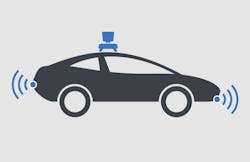Here’s the word many of you know very well by now: telematics. You’ve heard everyone talk about it from the OEMs to technical trainers to … me. I’ve been talking about it for three years, right? And as the theory goes, when telematics devices are fully entrenched in vehicles, it will completely change the way accidents are handled:
Someone is in an accident and the vehicle’s telematics devices notifies the manufacturer. The manufacture is now the one taking the first notice of loss. Then, the “OnStar effect” kicks in: “Mr. Anderson, we see that your vehicle has been damaged. Are you alright? We can get your vehicle delivered to a body shop, which is nearby; would you like you like to use one of our certified collision repair centers?”
It’s that simple, right? Now all of a sudden, it’s the OEM that leads and initiates this process. And you’ve heard me say this before, but this is why OEM certifications and approvals are so crucial to not just surviving but thriving in this industry moving forward.
So, here’s the question I get constantly: “OK, Mike, you’ve talked about this for three years; when is it going to happen?” People seem skeptical, but let me tell you, there are three reasons why this is going to happen far sooner than you realize.
(Quick disclaimer: Everything in this article is my opinion, based on extensive research I’ve conducted on the subject.)
1. The Generational Shift.
The technology is ready—and already there. This is possibly the largest misnomer about the emergence of telematics; many, many people think that there simply aren’t enough vehicles capable of this straight-to-the-OEM communication. Well, that’s not true, my friends. Just about every manufacturer out there has its own version of the OnStar system. Go to a new car lot, and ask. They are there and ready for vehicle owners to use.
But until recently, the hindrance on adoption has been the willingness of drivers to get connected. Think of my 79-year-old dad; he doesn’t want Big Brother knowing where he’s at. He doesn’t even like giving out his social security number at the doctor’s office! It’s very personal stuff, people.
Then there’s my 27-year-old niece. She’s not concerned. If she hears an insurer or manufacturer say that if they are able to monitor her vehicle she can get dollars off her insurance premium, she is all in.
And I think it’s been covered enough in this magazine for me not to have to tell you that it’s my niece who is your customer of today and tomorrow. There’s a generational shift taking place, and with that, there’s a shift in the adoption of technology. The younger generations want this technology, they want these features, and they will change that landscape very quickly.
2. Internet connection.
So, here was one of the biggest hangups with telematics in the past—there needed to be a way to connect the vehicle to the manufacturer. Now, with the advent of 4G networks, that’s possible, mainstream, and affordable. You can get it with GM for as low as $24.99 per month. And that offers more connectivity than just the telematics aspect of things.
You account for that generational shift—a generation that despite perceptions has still demonstrated through multiple studies that they value owning a vehicle—and the affordability and availability of the 4G networks, and you have all the makings of this taking off.
That’s particularly true when you take into account the most important and practical reason telematics will come on quickly:
3. First response time.
A lot of people ask what’s driving the concept of telematics and the connected car. Well, it’s really, really simple: driver safety. You’ve likely heard the statistics about the amount of accident-related deaths each year, and the National Highway Traffic Safety Administration has reported that 94 percent of all accidents are human error. Why wouldn’t OEMs put more technology into vehicles to keep drivers safe? And why wouldn’t drivers want that technology?
But let’s focus on the basic post-accident aspects of it. Sure, if you live in parts of California, the response time from emergency medical technicians (EMTs) can be fairly quick—roughly 6 or 7 minutes on average. But if you live in less populated areas, those times jump to anywhere between 22 and 32 minutes, often because no one is notified. Telematics can drastically lower those response times and save lives. It’s that simple.
So, there are three clear reasons that telematics is coming at you faster than you might think, and when it happens—and when first notice of loss is with the OEM—your method for getting those vehicles in your door will likely need to change. If you want to thrive in this industry for years to come, you need to be prepared for this switch, you need to be ready, and you need to have an OEM focus. It’s not a question of when this will happen, but of who—who will be the ones to step up?





